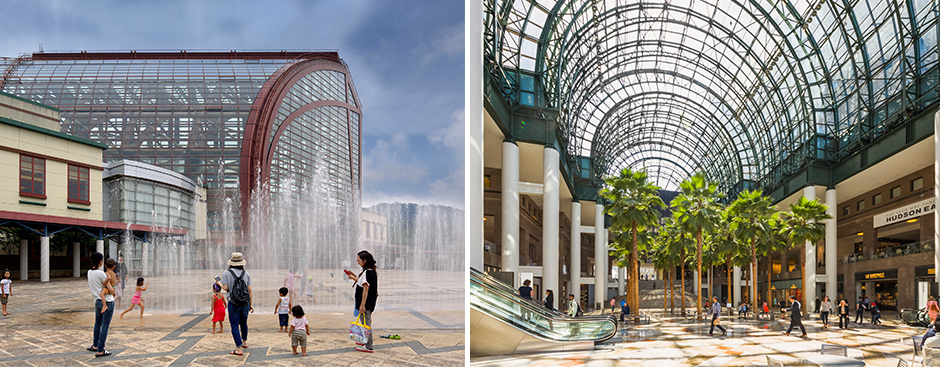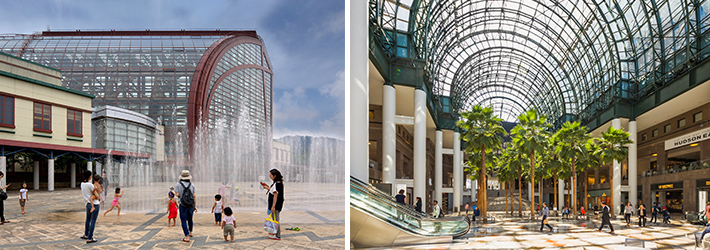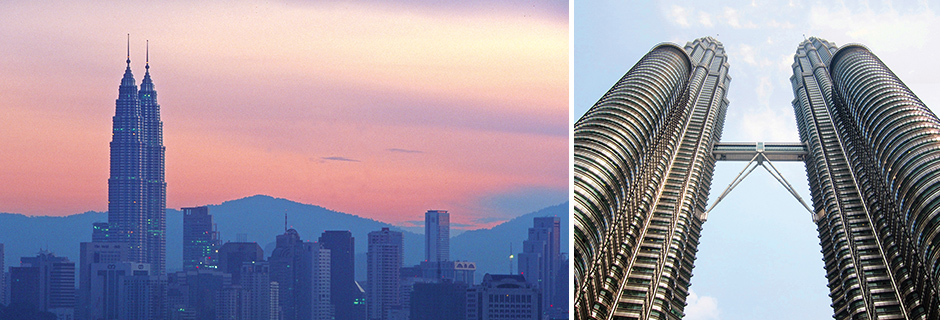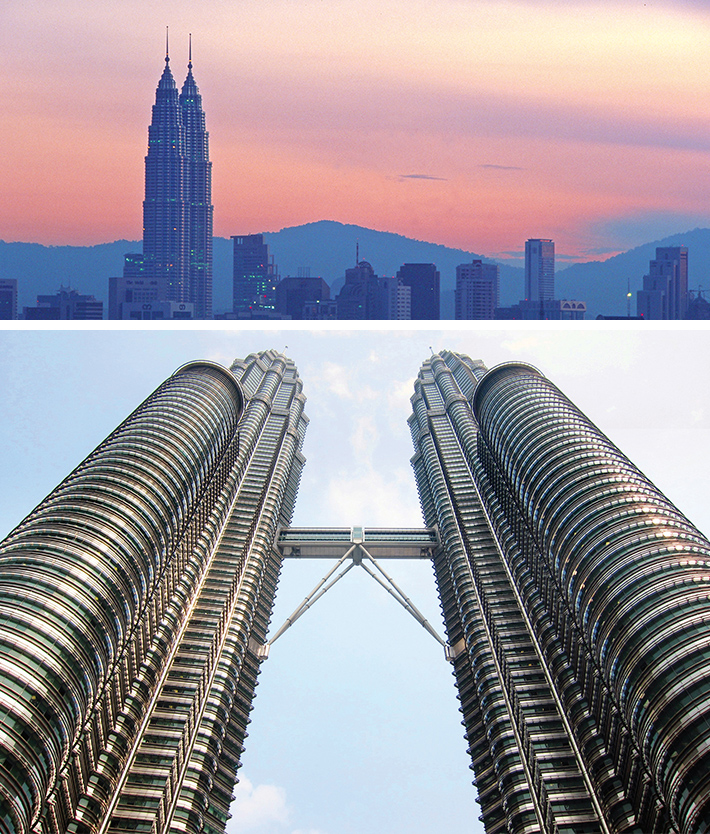Creating places for interaction
For Kurayoshi Park Square (2001, Kurayoshi City) in Japan, you created many “human spaces” for people to get together and have fun. Is it true that this was your idea, and not something originally requested by the client?
Pelli:
Yes it is. One of our important roles as architects is to offer greater value to the client by proposing devices not necessarily originally envisaged. Kurayoshi Park Square incorporated many atriums like those at the World Financial Center (WFC, 1986–88, New York). I place great importance on spaces like these where people can gather. Spaces for people to meet and give birth to new interactions and ideas are extremely important for urban living. Adding such spaces can greatly enhance the amenity of buildings.
So, it was more like creating a small city for people to meet, rather than a space within a building?
Pelli:
I believe any society needs its people to meet, and needs to have the means for people to meet. Buildings let people meet. So whenever I plan one, I do everything I can to capitalize on this strength. The winter gardens were not part of the original design of the WFC, but were welcomed by the client when we proposed them. They are great spaces, and very popular with users.
Where do ideas like that come from? Does it have to do with your cultural background, do you think?
Pelli:
Perhaps it does. Such spaces occupy a very significant place in Latin American life. Spain, Italy, and other southern European cities also have spaces purpose-built for gatherings. The desire to interact with others is probably part of human nature. This makes outdoor spaces surrounding the buildings very important. Such spaces are a part of the building, and the architect is therefore responsible for them. What is crucial when designing spaces that link the building and townscape is to think about the city—to pay respect to the city.
What are the necessary considerations for creating successful urban, open-access, piazza-like spaces?
Pelli:
Open public spaces are very important for the urban environment. A piazza-like space for people to meet and enjoy themselves needs to be programmed to attract people. Historically, open spaces have hosted a myriad of activities, such as religious and local meetings. Such spaces need something to enliven them. For a square to be successful, one needs to think beyond the square itself and its surrounding buildings.
In terms of size, the square should not be too large. Smallish squares tend to be livelier. The Plaza at the Rockefeller Center is relatively small, but is a hive of activity. I personally like the Piazza della Rotonda in front of the Pantheon in Rome because it also is very small. It used to be bland but is now home to many restaurants and coffee shops and has become very lively. It is a very good place for people to meet other people.


From left to right: ”Human space” of the Kurayoshi Park Square(2001), “Atrium” of the World Financial Center(1988)
Giving identity to a place
What is your view on the fact that cities around the world today are becoming increasingly homogenous? In Observations for Young Architects, you also discuss architectural styles and their methodologies. How do we go about creating designs unique to a given place?
Pelli:
Well, we are currently living in the midst of major change. The world is about to become powerfully interconnected. I am afraid cities all over the world have become uniform because the same technologies and same materials have become available everywhere. This is very difficult to stop because available options have also become homogenous. If we employ the same materials and build with the same technologies, the only scope for variation is shape, which I believe is where possibilities remain. There are several ways of doing this—for instance, we can, if we so intend, build identical buildings whether it is in New York or in Shanghai. But the design should ideally differ depending on how we respond to the site’s country, unique local history, and culture. Things that have existed locally, including buildings, are what people recognize as a culture unique to a locale, as in the townscape of Kyoto mentioned earlier. We must build buildings capable of winning local sympathy. Otherwise the building will not form a strong link with the local people. This is exactly what we achieved with the Petronas Twin Towers (1998, Kuala Lumpur). The building was greatly welcomed by the people of Kuala Lumpur.
The Petronas Towers are at once very modern and have a flavor of culture. It is a highly sophisticated design, but it is not easy to have a building of that caliber in every location, is it?
Pelli:
No, it isn’t easy. The Petronas Twin Towers project took a lot of effort. A project like this requires a huge amount of work.


Petronas Twin Towers by Cesar Pelli(1998)
Contact
当協会に関するお問い合わせはこちらからお気軽にどうぞ。
お問い合わせ頂いた内容や記入にあたっての個人情報
などは、
お問い合わせ内容に関してのみ利用させて頂き、
それ以外の目的には一切利用致しません。
